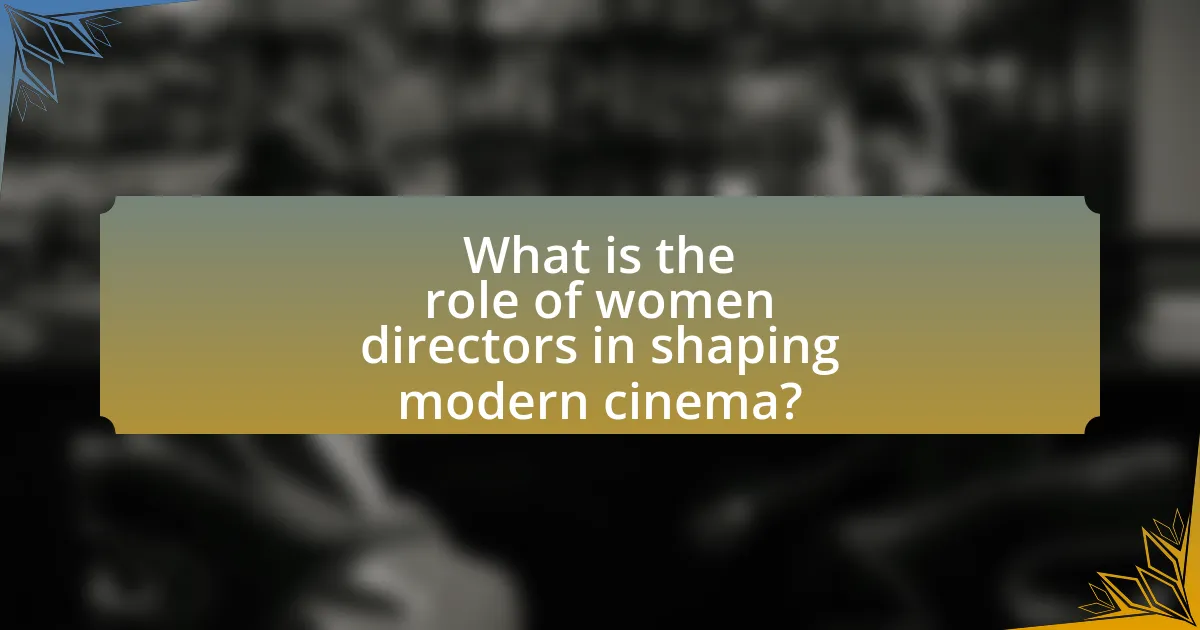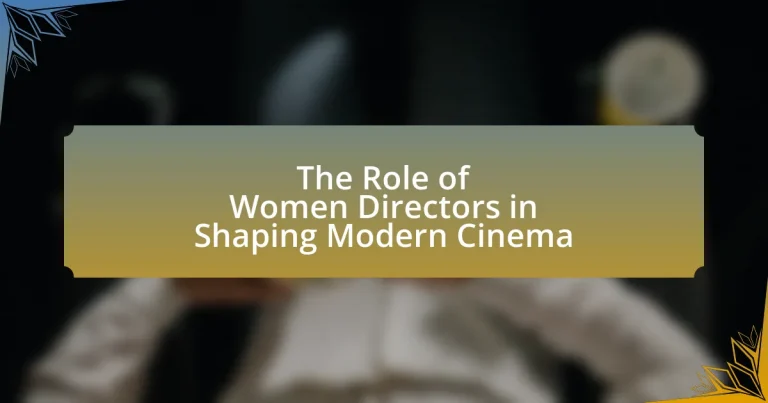The article examines the pivotal role of women directors in shaping modern cinema, highlighting their contributions to diverse storytelling and representation. It discusses how women directors have influenced film narratives and themes, challenged traditional gender roles, and achieved significant milestones within the industry. The article also addresses the historical context that has shaped their presence, the challenges they face, and the impact of societal changes on their opportunities. Furthermore, it explores strategies for overcoming barriers, the importance of mentorship and networking, and the future prospects for women directors in cinema.

What is the role of women directors in shaping modern cinema?
Women directors play a crucial role in shaping modern cinema by bringing diverse perspectives and narratives that challenge traditional storytelling. Their contributions have led to a significant increase in the representation of women and marginalized voices in film, influencing both the themes explored and the characters portrayed. For instance, films directed by women, such as “Lady Bird” by Greta Gerwig and “The Farewell” by Lulu Wang, have garnered critical acclaim and box office success, highlighting the demand for varied narratives. According to a study by the Center for the Study of Women in Television and Film, the percentage of women directing top-grossing films has increased from 4% in 2009 to 16% in 2019, indicating a gradual but impactful shift in the industry. This growing presence not only enriches the cinematic landscape but also inspires future generations of female filmmakers.
How have women directors influenced film narratives and themes?
Women directors have significantly influenced film narratives and themes by introducing diverse perspectives and challenging traditional storytelling conventions. For instance, films like “The Piano” directed by Jane Campion and “Lady Bird” directed by Greta Gerwig showcase complex female characters and explore themes of identity, motherhood, and personal growth, which were often underrepresented in mainstream cinema. Research indicates that films directed by women tend to feature more female protagonists and address issues such as gender inequality and societal expectations, as evidenced by the 2019 study from the Center for the Study of Women in Television and Film, which found that women directors are more likely to create narratives centered around women’s experiences. This shift not only enriches the cinematic landscape but also encourages broader discussions about gender roles and representation in society.
What unique perspectives do women directors bring to storytelling?
Women directors bring diverse and nuanced perspectives to storytelling, often emphasizing themes of empathy, relational dynamics, and underrepresented voices. Their unique experiences as women in a predominantly male industry allow them to explore complex female characters and narratives that challenge traditional gender roles. Research indicates that films directed by women tend to feature more female protagonists and address issues such as gender inequality and social justice, as seen in works like “The Farewell” by Lulu Wang and “Lady Bird” by Greta Gerwig. These films not only resonate with broader audiences but also contribute to a richer, more inclusive cinematic landscape.
How do women directors challenge traditional gender roles in cinema?
Women directors challenge traditional gender roles in cinema by creating narratives that center female experiences and perspectives, thereby subverting male-dominated storytelling. For instance, directors like Greta Gerwig and Ava DuVernay have produced films that not only feature strong, complex female characters but also address societal issues such as gender inequality and identity. Gerwig’s “Lady Bird” and DuVernay’s “Selma” exemplify how women directors can reshape the narrative landscape, offering alternative viewpoints that critique and expand upon conventional gender roles. This shift is supported by statistics indicating that films directed by women often receive higher ratings from audiences and critics, reflecting a growing appreciation for diverse storytelling in the industry.
What historical context has shaped the presence of women directors in film?
The historical context that has shaped the presence of women directors in film includes the evolution of gender roles, the feminist movements, and the gradual recognition of women’s contributions to the film industry. In the early 20th century, women were often relegated to subordinate roles in filmmaking, despite some pioneering figures like Alice Guy-Blaché, who directed over 1,000 films. The feminist movements of the 1960s and 1970s challenged societal norms and advocated for women’s rights, leading to increased opportunities for women in various professions, including film directing. By the late 20th century, organizations such as Women in Film were established to support female filmmakers, resulting in a notable increase in women directors, particularly in independent cinema. Statistics from the 2021 report by the Center for the Study of Women in Television and Film indicate that women directed 16% of the top 250 grossing films, reflecting ongoing progress and the impact of historical advocacy for gender equality in the film industry.
What milestones have women directors achieved in the film industry?
Women directors have achieved significant milestones in the film industry, including winning prestigious awards and breaking box office records. For instance, Kathryn Bigelow became the first woman to win the Academy Award for Best Director in 2010 for “The Hurt Locker.” Additionally, Greta Gerwig’s “Little Women” and Chloé Zhao’s “Nomadland” both received critical acclaim, with Zhao winning the Best Director Oscar in 2021, making her the second woman ever to achieve this honor. Furthermore, women directors have increasingly been recognized in major film festivals, with more female-led films being showcased and awarded, reflecting a growing acceptance and celebration of women’s contributions to cinema.
How have societal changes impacted the opportunities for women directors?
Societal changes have significantly expanded opportunities for women directors in the film industry. Increased awareness of gender equality and the push for diversity in media have led to initiatives that promote female filmmakers, such as the 50/50 by 2020 campaign, which aimed for gender parity in film festivals. Additionally, the rise of streaming platforms has created more avenues for women to direct projects, as these platforms often prioritize diverse storytelling. According to a 2021 report by the Center for the Study of Women in Television and Film, the percentage of women directing top-grossing films increased from 4% in 2009 to 16% in 2020, illustrating a positive trend influenced by societal shifts.
Why is representation of women directors important in modern cinema?
Representation of women directors is crucial in modern cinema because it fosters diverse storytelling and perspectives that reflect the complexities of society. Women directors bring unique experiences and viewpoints that challenge traditional narratives, contributing to a richer cinematic landscape. For instance, films directed by women, such as “Wonder Woman” by Patty Jenkins and “The Farewell” by Lulu Wang, have achieved both critical acclaim and commercial success, demonstrating that diverse voices resonate with audiences. Furthermore, research from the Center for the Study of Women in Television and Film indicates that films directed by women tend to feature more female characters and complex narratives, which can lead to greater gender equality in the industry and society at large.
How does the presence of women directors affect audience perception?
The presence of women directors positively affects audience perception by promoting diverse storytelling and representation. Research indicates that films directed by women often feature more complex female characters and address social issues from unique perspectives, which resonates with audiences seeking authenticity and relatability. For instance, a study published in the journal “Gender and Society” found that films with female directors received higher ratings from audiences, particularly among women, who felt more represented and engaged with the narratives. This shift in audience perception not only enhances the viewing experience but also encourages broader discussions about gender equality in the film industry.
What impact does diversity in directing have on the film industry?
Diversity in directing significantly enhances the film industry by fostering a broader range of narratives and perspectives. This inclusion leads to richer storytelling that resonates with diverse audiences, as evidenced by the success of films directed by women and people of color, which often outperform traditional narratives at the box office. For instance, films like “Black Panther,” directed by Ryan Coogler, grossed over $1.3 billion globally, showcasing the commercial viability of diverse storytelling. Furthermore, research from the USC Annenberg Inclusion Initiative indicates that films directed by women are more likely to feature female protagonists, thereby promoting gender representation and challenging stereotypes. This shift not only reflects societal changes but also drives innovation in filmmaking, ultimately enriching the cultural landscape of cinema.

What challenges do women directors face in the film industry?
Women directors face significant challenges in the film industry, including gender bias, limited access to funding, and fewer opportunities for high-profile projects. Gender bias manifests in the form of stereotypes that question women’s capabilities as directors, leading to a lack of representation in leadership roles. According to a study by the Center for the Study of Women in Television and Film, only 16% of directors of the top 100 grossing films in 2020 were women, highlighting the disparity in opportunities. Additionally, women often struggle to secure financing for their projects, as investors may favor male directors based on traditional industry norms. This combination of bias and limited access to resources creates substantial barriers for women seeking to establish themselves in the film industry.
How do industry biases affect women directors’ opportunities?
Industry biases significantly limit women directors’ opportunities by perpetuating stereotypes and unequal access to resources. These biases manifest in hiring practices, funding disparities, and a lack of mentorship, which collectively hinder women’s ability to secure directing roles. For instance, a study by the Center for the Study of Women in Television and Film found that only 16% of directors of the top 100 grossing films in 2019 were women, highlighting the systemic barriers they face. Additionally, research from the Geena Davis Institute on Gender in Media indicates that films directed by women receive less marketing support, further diminishing their visibility and success in a competitive industry.
What are the common barriers women directors encounter in filmmaking?
Women directors commonly encounter barriers such as gender bias, limited access to funding, and a lack of representation in key decision-making roles within the industry. Gender bias manifests in the form of stereotypes that question women’s capabilities as directors, leading to fewer opportunities for them to lead projects. Limited access to funding is evidenced by studies showing that female directors receive a significantly smaller percentage of film financing compared to their male counterparts; for instance, a 2020 report by the Center for the Study of Women in Television and Film indicated that only 12% of directors of the top 100 grossing films were women. Additionally, the lack of representation in executive positions within studios and production companies further restricts women’s ability to influence project development and secure resources, perpetuating a cycle of underrepresentation in filmmaking.
How do funding disparities impact women-led projects?
Funding disparities significantly hinder women-led projects by limiting their access to necessary financial resources. Research indicates that women directors receive only a fraction of the funding compared to their male counterparts, with studies showing that in 2020, only 16% of top-grossing films were directed by women. This lack of funding restricts the ability of women-led projects to secure high-quality talent, marketing, and distribution, ultimately affecting their visibility and success in the competitive film industry. Furthermore, the disparity perpetuates a cycle where fewer women-led projects are produced, leading to a lack of representation and diversity in cinema, which is crucial for storytelling and audience engagement.
What strategies can women directors use to overcome these challenges?
Women directors can overcome challenges by leveraging networking opportunities, seeking mentorship, and advocating for diverse storytelling. Networking allows women directors to build relationships within the industry, which can lead to collaborative projects and increased visibility. For instance, organizations like Women in Film provide resources and connections that empower female filmmakers. Mentorship from established directors can offer guidance and support, helping women navigate industry obstacles. Additionally, advocating for diverse storytelling not only enriches the cinematic landscape but also aligns with audience demand for varied perspectives, as evidenced by studies showing that films with diverse directors often perform better at the box office.
How can mentorship and networking support women directors?
Mentorship and networking can significantly support women directors by providing access to industry knowledge, resources, and opportunities for collaboration. Mentorship offers guidance from experienced professionals, helping women navigate challenges specific to the film industry, such as gender bias and funding disparities. For instance, a study by the Geena Davis Institute on Gender in Media found that women directors with mentors are more likely to secure funding and lead successful projects. Networking facilitates connections with peers and industry leaders, which can lead to job opportunities and partnerships. According to the Women in Film and Television report, women who actively network are 50% more likely to be hired for directing roles compared to those who do not engage in networking. Thus, both mentorship and networking are crucial for empowering women directors and enhancing their visibility and success in the film industry.
What role do film festivals play in promoting women directors?
Film festivals play a crucial role in promoting women directors by providing a platform for their work to be showcased and recognized. These festivals often feature dedicated sections or awards for films directed by women, which helps to elevate their visibility in a predominantly male-dominated industry. For instance, the Sundance Film Festival has made significant efforts to support female filmmakers, with statistics showing that in recent years, around 40% of the films selected for competition were directed by women. This visibility not only helps to attract funding and distribution opportunities for women directors but also fosters networking and mentorship opportunities within the industry, further empowering female voices in cinema.

What are the future prospects for women directors in cinema?
The future prospects for women directors in cinema are increasingly positive, driven by a growing recognition of their contributions and a push for diversity in the industry. Recent statistics indicate that women directed 16% of the top 100 grossing films in 2022, a significant increase from previous years, reflecting a gradual shift towards gender equity in filmmaking. Initiatives such as the 50/50 by 2020 campaign and various funding programs aimed at supporting female filmmakers further enhance opportunities for women directors. Additionally, the success of films directed by women, such as “Nomadland” and “Promising Young Woman,” demonstrates their ability to resonate with audiences and critics alike, paving the way for more projects led by women.
How is the landscape of film directing changing for women?
The landscape of film directing is changing for women as they increasingly gain recognition and opportunities in a historically male-dominated industry. In recent years, the percentage of women directing films has risen, with studies indicating that women directed 16% of the top 100 grossing films in 2021, up from 12% in 2020, according to the Center for the Study of Women in Television and Film. Additionally, initiatives like the 50/50 by 2020 campaign have aimed to achieve gender parity in film directing, further promoting women’s involvement. This shift is also reflected in awards, with women directors like Chloé Zhao winning the Academy Award for Best Director in 2021, highlighting their growing influence and success in shaping modern cinema.
What trends indicate a growing presence of women directors in mainstream cinema?
The growing presence of women directors in mainstream cinema is indicated by an increase in the number of films directed by women, as well as their recognition in major film awards. For instance, the percentage of films directed by women in the top 100 grossing films rose from 4% in 2018 to 12% in 2022, according to the Center for the Study of Women in Television and Film. Additionally, women directors have received significant accolades, with films directed by women winning 20% of the Best Director awards at major film festivals in 2023, showcasing their impact and visibility in the industry.
How can emerging technologies impact women directors’ storytelling?
Emerging technologies can significantly enhance women directors’ storytelling by providing innovative tools and platforms for creative expression. For instance, advancements in virtual reality (VR) and augmented reality (AR) allow women directors to create immersive narratives that engage audiences in unique ways, expanding the boundaries of traditional storytelling. Additionally, the rise of streaming platforms has democratized access to distribution, enabling women directors to reach wider audiences without the constraints of traditional film industry gatekeeping. According to a 2021 report by the Center for the Study of Women in Television and Film, films directed by women are more likely to feature diverse narratives, showcasing the potential for technology to amplify underrepresented voices in cinema.
What can be done to further support women directors in the industry?
To further support women directors in the industry, implementing mentorship programs specifically designed for women in film can be highly effective. These programs can connect emerging female directors with established industry professionals, providing guidance, networking opportunities, and resources that are often less accessible to women. Research indicates that mentorship significantly enhances career advancement; for instance, a study by the Center for American Progress found that women who have mentors are more likely to receive promotions and higher salaries. Additionally, increasing funding for projects led by women directors can help address the financial disparities they face, as women-directed films received only 12% of the total box office revenue in 2020, according to the Annenberg Inclusion Initiative.
What initiatives are currently in place to promote women in directing roles?
Several initiatives are currently in place to promote women in directing roles, including mentorship programs, funding opportunities, and industry partnerships. Organizations like Women in Film and the Sundance Institute offer mentorship programs specifically designed to support female directors, providing them with guidance and resources to advance their careers. Additionally, funding initiatives such as the Athena Film Festival and the Women’s Media Center provide financial support for projects led by women directors, aiming to increase their representation in the industry. Furthermore, industry partnerships, such as those between major studios and advocacy groups, work to create more equitable hiring practices and promote female talent in directing roles. These initiatives collectively aim to address the gender disparity in film directing and empower women in the industry.
How can audiences contribute to the success of women directors?
Audiences can contribute to the success of women directors by actively supporting their films through attendance, promotion, and engagement on social media platforms. When audiences choose to watch and discuss films directed by women, they help increase visibility and box office revenue, which can lead to more opportunities for these directors. For instance, films like “Lady Bird,” directed by Greta Gerwig, received significant box office success and critical acclaim, largely due to audience support, which demonstrated the demand for women-led narratives in cinema. This support can also influence studios to invest in more projects helmed by women, as demonstrated by the increase in female-directed films following successful releases.
What are the best practices for aspiring women directors in modern cinema?
Aspiring women directors in modern cinema should focus on building a strong network, honing their craft, and advocating for diverse storytelling. Networking is crucial as it opens doors to collaborations and mentorship opportunities; studies show that women in film benefit significantly from connections with established industry professionals. Additionally, continuous skill development through workshops, film school, or online courses enhances technical and creative abilities, which is essential in a competitive field. Furthermore, advocating for diverse narratives not only enriches the cinematic landscape but also aligns with industry trends that increasingly favor unique perspectives, as evidenced by the growing success of films directed by women that highlight underrepresented voices.


